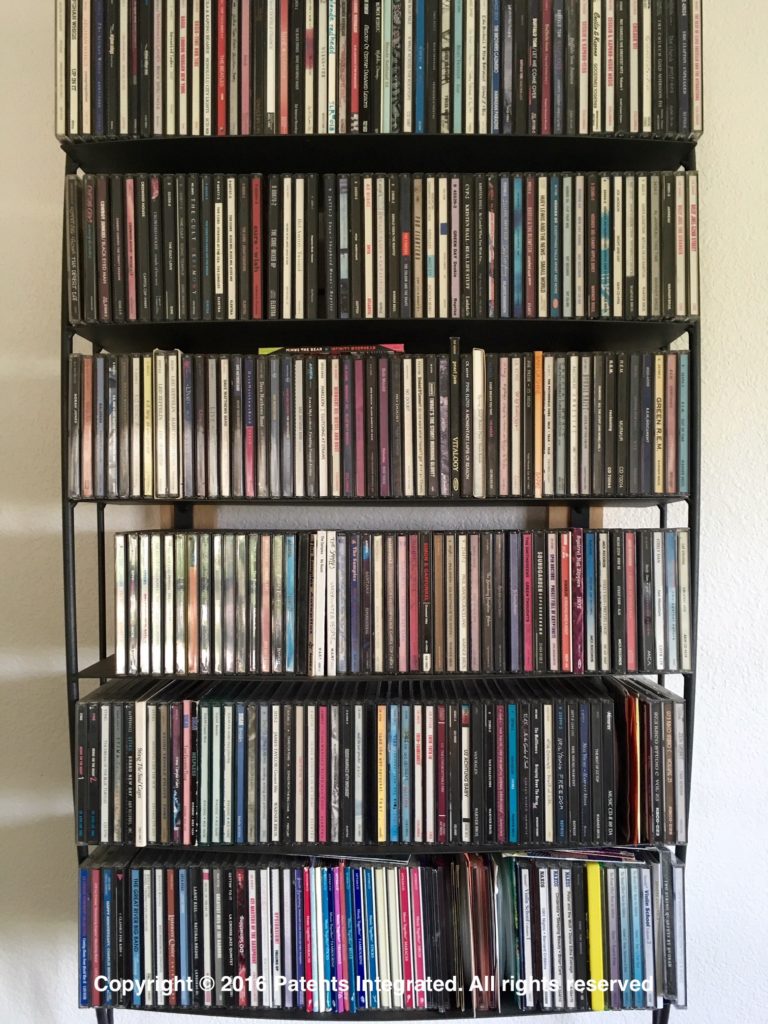This article is part of the “What Should I Do (WSID)?” series where I discuss various scenarios involving intellectual property and business. Topic suggestions are always welcome.
“I have an innovative idea! What should I do?”
In previous posts, we explored the question of whether or not you should seek patent protection for your innovative idea, as well as how you can discuss your innovative idea with others. Here, I’ll look at the question of how to determine your endgame with respect to your intellectual property (IP).

I like music (a nod to the Black Eyed Peas for my title this week). From my teen years, I collected CDs of my favorite music and, even though I’ve pared down over the years, I still have hundreds of albums on CD.
The problem is, I no longer have a functioning CD player. I pretty much only listen to downloaded music or streaming services, and my CDs are mostly for decoration and nostalgia.
Is your IP sitting on a wall collecting dust, just like my music CDs?
At the start of this series, when you were considering to patent or not to patent, I’d asked you to contemplate questions related to your future plans in using your innovative idea. Why should you be considering the IP endgame before you’ve even decided how to protect your innovative idea? It’s because what you ultimately want to do with your innovation can greatly affect the specific steps you take to protect your innovative idea.
Let’s look at six possible scenarios:
- You want the self-satisfaction of having a patent to your name, maybe even a fancy plaque.
There’s absolutely nothing wrong with this scenario. Not everyone has innovative ideas, and feel free to celebrate your accomplishments.Depending on your budget, you can try your own hand at patent prosecution as the pro se inventor applicant. There are online and paper publications that can help, or talk with a patent professional to identify ways to get a patent as quickly and as economically as you can. The USPTO has a lot of nice resources, including this webinar. - You want to create new products based on your idea.
Start by taking a look at the product ecosystem around your innovation. Are there existing, competing products? Are there established competitors? How have the competitors protected their products from upstarts? Are your suppliers/vendors pursuing IP? What IP do your potential customers hold? What is the IP landscape around your innovative idea? Do your competitors have any intellectual property that might be infringed by your proposed new product? Are there ways to engineer your product around the competitor IP?Also consider how you might be able to define and protect your competitive edge. How does your product differ from the known competing products? What value-add does your product offering provide? Are these value-add features protectable by trade secret or patents? How easy would it be for a competitor to reverse engineer or copy the value-add features?You want to make sure you can sell your product without stepping on other people’s IP, and simultaneously be assured that your innovative ideas can be protected to provide a sustainable competitive advantage. You’ll need to take much greater care in creating an IP strategy and crafting any IP filings than in Scenario #1. Be sure to consult an IP professional, such as a patent attorney or patent agent.
- Your innovation is an improvement to an existing product, and you’d like to partner with another entity to create an improved product.
The considerations here are similar to Scenario #2 above, except you are focusing on protecting the improvement that your innovation provides, as well as trying to make your improvement as seamlessly integratabtle with the existing product as possible. Before you talk to the potential partner, be sure to review the ideas discussed in the previous post about discussing your innovative idea with others. Also, make sure you can document ownership off your innovative idea — this topic deserves a blog post of its own, which I’ll publish in the near future.You are essentially trying to position your innovation to be as attractive as possible to your potential partner. At the same time, you are making sure that, even if a product development partnership doesn’t work out, you would be able to maintain ownership of your innovative idea. These considerations are particularly important if the potential partner is a large, well-established company. - You want to start a product company around your innovative idea as well as future innovations.
If you are going to be investing the time and energy required to start a company, proceed with caution, mindfully evaluating the risks. Make sure you have established the appropriate framework, taking into consideration corporate hygiene issues like equity distribution among the founders (a complex topic for future post), as well as carefully examined the question of to patent or not to patent. Again, make sure that you have documentation clearly showing that your company owns the IP.I assume you feel that this innovative idea is a big one. Consequently, I’m sure you’re also very passionate about your new venture. That’s great! Keep in mind that passion with a dose of reality will help increase your chances of success (see, for example, “Passion, Reality, and Starting a Business” by Bert Shlensky). Making conscious decisions to ensure alignment of your business goals, product development path, and IP strategy will be a key factor in building your business. - You are positioning your company for an exit event, and would like to boost your IP portfolio and, hopefully, your company’s valuation.This situation is a bit specialized in that, really, the exit event is your true endgame for your company. However, your endgame for your IP portfolio (since you’ll likely soon be transferring it to an acquirer) is to maximize its value such that your company valuation is as high as possible. There are a number of things you can do to increase the actual and perceived value of your IP portfolio.
One easy action you can take is to know the status of every IP asset, including patents, trademarks, copyrights, and trade secrets. Make sure all of these assets are in good standing, with up-to-date maintenance fee payments as needed, and with a clear chain of ownership. For pending applications, make sure any required office action responses have been addressed and/or will be filed in a timely manner. Here’s a detailed checklist, for example.
Another possible action, specifically for patents, if you already have issued patents, having one or more pending patent applications in the same patent family is a good thing, as a savvy acquirer would know pending applications can give the prospective new owners a lot of options as to how they might shape the patent portfolio to shape their needs. So, if you have the chance, do file that Continuation/Divisional/Continuation-in-Part. Not familiar with CONs/DIVs/CIPs? Be sure to talk with your friendly patent professional, either a patent attorney or patent agent. I’ll write more about the mechanics of CONs, DIVs, and CIPs in a later post.
- You don’t necessarily want to make product, and you’d prefer to try to license your innovative idea to an existing company.
Know that this path is not an easy one. It’s easy to get labeled as a “patent troll” if you don’t intend to develop a product based on your innovative idea. I can debate the merits of definitions such as this one — that’s probably a post for another day.Essentially, a patent grants to its owner a legally enforceable right to exclude others from practicing the invention described and claimed in the document, and it is a form of property, such that the rights symbolized by a patent can be inherited, sold, rented, mortgaged and even taxed. Nowhere in the patent laws is it required that the inventor actually produce even a prototype of his or her innovative idea in order to be granted a patent. HOWEVER, if you even approach a third party about taking a license to your innovative idea, then you need to be cognizant of any “anti-troll” statutes that may be applicable. These statutes vary state-by-state.Unless you yourself are a patent professional, I would not advise trying your hand at licensing activities yourself. There are lots of recent articles (such as this one) talking about inventors having a hard time with such activities. Even if you are a patent professional, unless you have experience in patent transactions, I would highly recommend you seek the assistance of a patent licensing expert.
Patent licensing/enforcement is a complex and litigious business, and mistakes can be costly. If you do not intend to develop a product, then the default alternative is Scenario #1.
In the end, your IP endgame is a highly personal matter, depending on your ambitions, time frame, and risk-tolerance. Be sure to discuss the pros and cons of the different scenarios with someone with legal knowledge who can examine your business goals as well as your technical savvy and appetite for risk.
About the Author and Disclaimer: Yoriko Morita has worked with innovators in a variety of contexts, in a law firm working for inventors, as in-house IP director, and as a licensing professional. She currently helps clients with such IP-related questions, as well as developing integrated business/technology/patent strategies, through her company, Patents Integrated. The contents of this article are intended to be informational only, not legal advice. The reading of this article does not establish an agent-client privilege between you and Patents Integrated, and Patents Integrated is not responsible for any damages arising from your use of the information in this article under any circumstance. Your use of the information in this article is at your own risk, and you should seek the advice of a licensed legal professional regarding your own specific situation.

